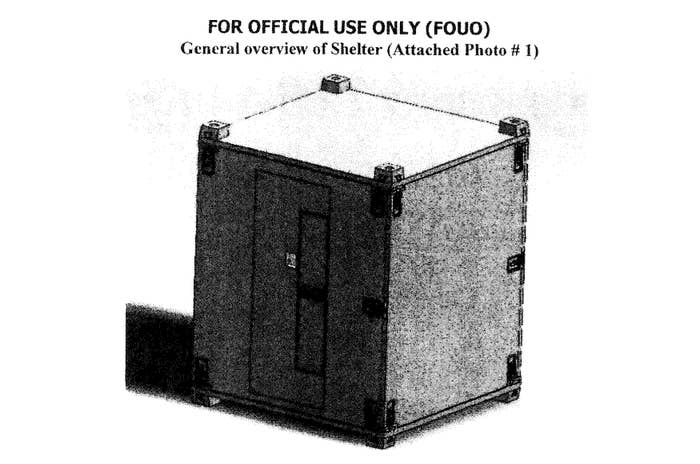
The U.S. military is looking at a new way of holding detainees in the field, according to government procurement records: small, prefabricated cells, designed for solitary custody and barely big enough to lie down in, that could be deployed to war zones.
The Army is looking for information from contractors who could design and build a "modular detainee shelter system," according to an announcement on fbo.gov that was posted in November. Each "closed, box-like" shelter would be "a holding cell for one detainee during combat operations."
Two former military officials familiar with detention in combat zones said that at times, commanders have had to come up with detention options on the fly. In Afghanistan, for example, prisoners were kept in tents in Kandahar in the early days of the conflict, and then transferred to a warehouse on the Bagram air base. In Iraq, prisoners were sometimes held in large shipping containers or tents.
These new cells, which would be collapsed for transportation, would have "tamperproof" interiors. The door to the cell could be padlocked shut from the outside, and would have a five-inch square window, also tamperproof. The door would also have two small access holes, one for passing food to the inmate, and the other for locking and unlocking handcuffs.
The cells, as described in a detailed sheet, would have an internal area of at least 40 square feet, and would stand eight feet with a width of about seven feet. They would have heat and air-conditioning and be able to hold their detainees in any environment, from the South Pole to the Sahara. The "operational temperature" of the cells would be from 40 degrees below zero to 120 degrees, and would be designed to resist not just "the effects of blowing sand," but also a heavy load of snow, according to the specifications.
When the Army was done with the cells, they could be disassembled and shipped away.

Retired Army Colonel Wesley Martin, who worked on detainee operations in Iraq, said in an interview that he had never heard of transportable cells like these. He said that while there might be some benefit, he could also see potential problems. "As a temporary short-term holding cell I can see it being legal," he said. "It would make sense."
But if detainees were held in boxes for any longer period, he said, "there would be humanitarian concerns."
Retired Marine Corps General Douglas M. Stone, who oversaw detention operations in Iraq in 2007 and 2008, said in an interview that while he'd never seen stand-alone collapsible single-cell modules like these, he himself invented a similar idea for operations at Camp Bucca in Iraq, though not for individual inmates. He said he came up with something called the Modular Detainee Housing Unit, or MDHU, which held 10–15 inmates: "I designed it so we could move people out of all those tents we had."
Stone said the concept being explored by the Army sounded like it would work well for interrogation and intelligence operations, where detainees are isolated from each other. Generally, though, solitary confinement is supposed to be rare: "The rules of solitary confinement and separation are pretty tight. Generally we avoid that."
But, he said, these little cells could could be more humane than the other options available in the chaos of a war zone. "Imagine if you go into some place," Stone said, "you can't put em into your Humvee; you can't put them in a tent you built, you don't want to spend resources to guard them, and you don't want to handcuff them to a tree. But you want to have them held until you can complete your interrogation."
In an interview, Jamie Kiser, an official at the Army contracting office that released the request for the detention equipment, said there was no funding for it yet. She would not say which component of the Army had commissioned the effort.
